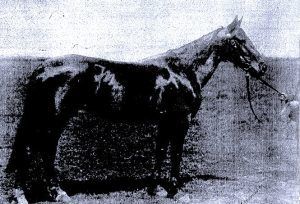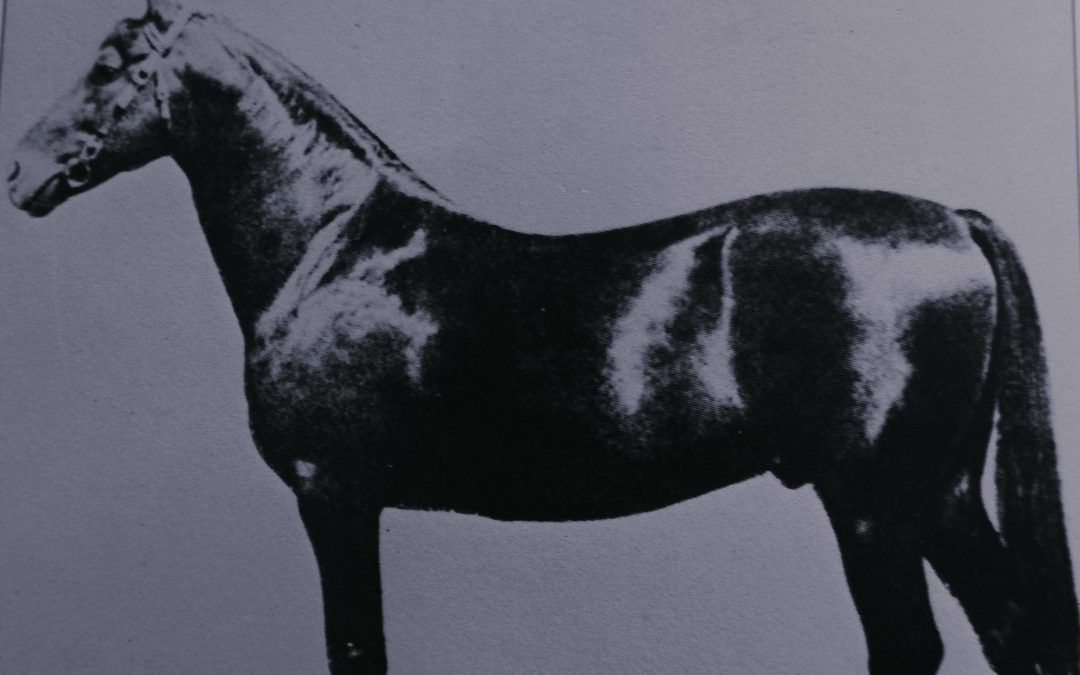THE STARS BEFORE THE DAWN
Pic. Childe Harold the celebrated 19th century racehorse and stallion (1500 words)
Even harness historians use the opening of Addington as the main starting point of big time harness in New Zealand-as it was.But easy to overlook that it was the popularity of trotting made by a band of high class horses in the years prior that fuelled the drive for a better venue.
Several of those were heroes of those hours. Two of them were champion trans- Tasman mares who lingered in the record books for over a decade.There would have been a third,the former local, Calista,but she had been sold to Australia where she became a star, breeding regular foals while beatingt he best on the track.Though she could be erratic,her absence played a role in the arrival of the two Australians.
One,Rita, was a heroine in Auckland and especially Canterbury, holding the three most important records then- for one mile harness and saddle;two miles (3200)-saddle and harness; and three miles-as well as the best time for one mile and a half (2400m).The other,Yum Yum, held the outright mile record for nearly 10 years and ran off some of the longest handicaps in big races in our trotting history. That prevented both from winning more big races but never broke their spirit.
The mares came separately but specifically for the Auckland meetings of the early 1890’s. Yum Yum was already 6 years old.Remarkably, she was still going around in open class races at Alexandra Park at the age of 20- beating, and being beaten, by her well performed son,Waitekauri-who by then was himself 10 years old.

An ancient phot of an ancient star. Yum Yum poses for an early camera
Sometimes one or the other of mother and son was eased to help their stablemates chances.
A few years before it would have caused a riot but the new fangled bracketing stablemates with same owners,unlike some stormy days on the galloping courses because thoroughbred bosses wouldn’t follow suit, left Auckland punters unconcerned.
Both mares were by Childe Harold (main photo) an American sire who somehow slipped through the Kiwi net.Our pioneer standardbreds often came from the same property in Glasgow where James Hendrie quarantined and acted as an agent for American horses. Kiwi Robert Wilkin owned nearly every southern hemisphere- bound stallion through Scotland at the time but while his own imports were influential they didn’t match two that got away.
He brought Vancleve to New Zealand then leased/later sold him to Australia where he left stars and legends;and he had already passed Childe Harold on to Andrew Town to complete a very unenviable double.Harold, a grandson of Hambletonian himself was the superstar sire of New South Wales for a decade after a colourful racing record in Britain Europe and Australia
It was James Jarden who brought the Childe Harold line here importing subsequent landmark stallion, Rothschild to Christchurch. But it was his second option. The original interest was in Rothschild’s headline brother Osterley,Australia’s champion track performer (next to Fritz) but the price was too high.
Dan O’Brien, the former Riccarton- based owner of the immortal galloper Carbine, (and the one who had sold Calista to Australia and was then living there) , suggested Osterley’s much slower brother would fit the bill. Rothschild may have been a slowcoach but turned out a huge influence in New Zealand breeding. Ironically,Osterley was something of a disappointment as a stud horse.
Yum Yum was brought over by her owner, grazier Bob Craig, in 1892. He rode her on the campaign but realising the odds were against him, later sold the mare to George Budge a prominent owner of both gallopers and trotters in that era. Budge bred Waitekauri from Yum Yum but then the mare was raced by long established Auckland pony and standardbred enthusiast, William Greenwood.
An odd aspect of the deal over Yum Yum was that it was a condition of sale that she be bred three seasons in a row to the the well performed Auckland-based American stallion Albert Victor who had been brought over by George Budge personally from California.It never happened.Albert Victor was a top racehorse and sire often competing against Yum Yum on the track but Greenwood’s own US- bred stallion, La Rue,took preference in the breeding paddock. He was ok but no Albert Victor.
Craig found the local handicappers laying in wait.
In the 1892 Auckland Cup she gave 93 seconds start to one of the favourites, Fairy, and ran second. That was some feat, for Fairy was turning into the straight near the end of its first lap of the track when Yum Yum was just starting ! Starts of up to 58 seconds over shorter trips were not unusual.
As a result Yum Yum was sent south for the first free- for-all run in New Zealand, the Champion Stake of 1895 at Lancaster Park.
She got into a fence days before and missed that historic event, but at the Showgrounds for the Canterbury Trotting Cup while on the trip she won in a mile saddle mile record of 2.27 which stood as a national record for many years.
That Champion Trot at Lancaster Park was won by Rita who took two of the three heats beating the local hero,Stonewall Jackson. That was after she had won a feature in Auckland pointlessly off a long mark hailed as “the most splendid display of trotting ever seen at Potter’s Paddock” ( Alexandra Park)
Rita was a Robin Dundee of her time. A striking black with a beautiful head and so petite (14.2hh) she could have qualified for pony racing,she was all-American bred,not that common in that era-(Yum Yum was from an Australian- bred part- thoroughbred mare) .Rita spent much of her career in Canterbury and Otago.She was the darling of the crowds wherever she went, win or lose, her round of applause often outshining that of the horse who had mastered her.
She came to New Zealand in 1894 soon after after losing a match in Australia with the American imported pacer,Mystery, a race few outside her prominent owner Frank Palfrey thought the tiny trotting mare could win- despite being “the best all round mare ever seen in Australia”. A similar claim was later made about her New Zealand profile by one of our leading reporters.
Rita was sold by Palfrey to Otago owner,James McKewen, but when an ownership irregularity prevented his nominating for any of the few feature races of the time she was sold to Christchurch businessman, Victor Harris. A dual code enthusiast Harris played a major role in the promotion of the Addington project-a highly controversial idea making Lancaster Park club the chief, prompting resignations,fierce arguments and rebellion among rival clubs. The Minister of Racing fixed that simply by announcing that opposition meant only Addington would get permits to race.Strong leadership!
Rita’s trainer/rider was Bobby Reay whose father was a riding/training legend of 19th century New Zealand galloping while his son was married to a Miss Kerr, from the equally famous trotting family from Wainoni,the most outstanding breeder-trainers of that time.They stood Wildwood at stud and had the great broodmare Thelma there at the same time.The stud was a showplace.
Reay had followed his father successfully into jockey ranks but,suffering health affects from injury,then followed his wife’s side of the family so he could stay active in racing.He also owned the hugely popular pony trotter Parnell. He had a rare understanding of Rita the little black mare often racing lonely off long marks, Reay judged her times and finishes to a nicety.In Dunedin in 1895 the combination won a feature by 35m. She was the leading stakes earner of the season more than once and when the Prime Minister Richard Seddon carried out an inspection of the Canterbury race tracks in 1896 little Rita was the one who was paraded before him as the queen of the tracks.
Being trained by Reay had another advantage.He was allowed to train them on the Riccarton track,easily the best training surface in the country.
Spectator,the leading racing scribe in Christchurch in that era, described Rita setting a record for one mile and a half (2400) as “the best I have yet seen in the colony”
There were some genuine stars to beat then,especially Young Irvington,Brooklyn; the first NZ Cup winner Monte Carlo; Kentucky; Stonewall Jackson (the holder of several long distance race records) etc all with their champions and sometimes engaging in street races to help owners pay expenses.
Neither of these two mares amounted to much as broodmares perhaps why their racetrack reputations faded.It was perhaps not surprising given their long racing careers; in Yum Yum’s case her female line and in Rita’s case her diminutive size were no help
But the pair, so often lonely languishing off impossible marks while horses half as good were winning, never lost their public appeal.
Every time you watch a big race go round at Addington, give a fleeting thought to two great mares who once had the public roaring. It was they who drove the public demand for the something better Addington became.
